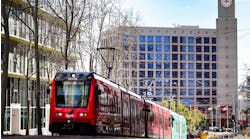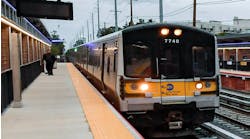Several factors will influence the development of the transit industry during the next 12 months. The topics on this list, including the embracing of data management, a continuing transition to lower emission fleets, a shift in the bus manufacturing landscape and the November election in the U.S., provide a glimpse of what subjects could shape the industry in 2024.
Sustainability efforts and climate change
The North American transit industry continues to move toward more sustainable fleets and business practices. In the most recent CALSTART “Zeroing in on ZEBs” report from February 2023, full-size transit zero-emission buses (ZEBs) increased 66 percent over the report’s 2021 count to 5,480 buses nationally. Fuel cell electric buses saw a 64 percent increase in adoption since 2021 and adoptions of small ZEBs grew by 42 percent across the country. In Canada, the total number of ZEBs grew to 859, including 219 new full-size buses.
This growth in ZEB deliveries is also confirmed by OEMs. In a Fiscal Year (FY) 2023 Quarter 3 earnings call, NFI Group Inc. reported its zero-emission bus deliveries had increased from eight percent in 2020 to 23 percent in the third quarter of 2023. The company says it expects zero-emission buses to be at least 40 percent, and even up to 50 percent of its deliveries in 2025.
Encouraging people to take transit is also a key factor in supporting sustainability goals. In Colorado, the state’s Zero Fare for Better Air program was designed to reduce ground-level ozone by increasing the use of public transit across the state. Colorado’s largest transit provider, the Denver Regional Transportation District (Denver RTD), published a final evaluation report outlining the overall impact of the initiative. The final report shows an increase in customer boardings and estimates a reduction of approximately 9 million vehicle miles traveled during July and August 2023. Additionally, estimates show more than 6 million pounds of greenhouse gases were eliminated when individuals opted to use public transit instead of a single occupancy vehicle.
Data is king
Transit has rapidly morphed into a digital business during the past decade. It’s a trend that will intensify as new fare systems come online, more mobility options are integrated and artificial intelligence applications and smart city practices are better understood and applied.
The challenge with this quick pace of exploration and adoption will be to ensure the data collected is clean and it is stored and managed in a secure way. While large urban agencies have brought data scientists into their ranks, smaller agencies may not have the budgetary wiggle room to add expertise in data governance or data architecture. Pressure will be on the business community supporting transit agencies to develop tools and platforms that will help them parse through the data available to find useful information that can inform agencies’ actionable outcomes.
Bus manufacturing teeters on edge of crisis
U.S. bus manufacturing has been on a slow march to the precipice of crisis driven by supply chain issues, inflation and a highly competitive market. Significant changes in the past six months brought shifts to the competitive landscape of the U.S. and Canada heavy duty OEM line up. In June 2023, Nova Bus announced it would cease U.S. bus production in early 2025, Proterra filed for bankruptcy in August 2023 and, ultimately, sold its transit business line to Phoenix Motor Inc. Most recently, REV Group announced plans to close its ElDorado National-California business by the end of FY 2024. This all comes as funding included in the Infrastructure Investment and Jobs Act (IIJA) is fueling increased demand for buses.
The market for smaller transit vehicles is also fraught with issues, including price increases, delays and cancellation of orders. An August 2022 survey conducted by the Community Transportation Association of America found smaller transportation providers saw price increases between 30 and 70 percent, with 80 percent of survey respondents reporting they felt “highly concerned with the state of standard vehicle replacements.”
While appropriately sized vehicles for smaller transit providers may be available globally, they do not always meet Buy America requirements federal grant recipients in the U.S. must adhere to. A consortium of 10 transit providers filed a temporary Buy America waiver for a low floor, 20-foot, zero-emission minibus with the Federal Transit Administration in August 2023. If approved, the temporary waiver would allow consortium members to procure a purpose-built minibus while the manufacturer works to bring its product in compliance with Buy America requirements.
The issues within the bus manufacturing market have been recognized by the American Public Transportation Association (APTA), which created a Task Force on Bus Procurement to address strengthening the bus industry in the U.S. The task force - led by Chicago Transit Authority (CTA) President and APTA Immediate Past Chair Dorval Carter and New York City Transit President Rich Davey – released its recommendations at the beginning of February. They included recommendations that transit agencies consider price adjustments to exiting bus procurement contracts, progress payments and the suggestion to include a vehicle price adjustment mechanism in future procurements that would utilize indices to reflect price inflation/deflation.
The same day the recommendations were released publicly, stakeholders from the industry met with policy leaders in Washington, D.C., to discuss the bus manufacturing challenges. Following the meeting, FTA issued a Dear Colleague letter outlining tools available to U.S. transit agencies procuring transit vehicles with federal funds.
The letter explains the following tools can be used by transit agencies and TVMs:
- Contract modifications for price adjustments are allowed depending on factors, including contract terms, applicable local, state or tribal procurement law, the terms of a price adjustment and the scope of the contract modification.
- FTA grant recipients can seek additional federal funds to cover contract price increases while
- FTA formula and certain other federal funds can be used to cover contract modifications for price increases.
- New procurement clauses such as price adjustment clauses and a “brand name or equivalent” clause.
- Advance payments, which allows a contractor to receive payments prior to the contractor incurring costs.
- Progress payments, also known as milestone payments, allow a contractor to receive payments prior to all work being completed.
- If no advance payments or progress payments are being made, no performance bond or letter of credit is required under federal law. However, if advance or progress payments are being utilized, security is required.
FTA’s letter also encourages federal funding recipients to utilize procurement strategies such as state contracts and performance-based specifications to lower costs of the procurement. .
Flexibility and reach of transit service
More than two-thirds of transit agency respondents to Mass Transit’s Mobility Outlook survey report reduced ridership continues to be a residual impact from the pandemic. Since hitting the bottom of the ridership trough in March 2020, weekly transit ridership has been on a slow, but steady increase, according to data from APTA. Between late August 2023 and mid-January 2024, weekly ridership in the U.S. stayed between 72 percent to 77 percent of pre-pandemic numbers.
To continue to serve the changing mobility patterns of their communities, transit agencies have explored alternative services and integrated more travel options. This can be in the form of system redesigns or strategic redesigns of busy routes, expanded microtransit or on-demand options, first and last-mile mobility options and expanded allowable times bikes or scooters can be brought onboard fixed route vehicles.
One example is FlexRide Milwaukee, which began service in 2022 as a pilot with routes to the north and northwest sides of the Milwaukee region. Additional funding and a new service provider saw FlexRide expand its reach. The service celebrated its 50,000th ride in early January 2024.
In addition to rethinking services, more systems are implementing fare capping, reevaluating fare structures or easing the barrier to access discounted passes.
In the Chicago region, the Regional Transportation Authority (RTA) of Northern Illinois, Metra and Cook County launched the Access Pilot Program on Feb. 1, which extends reduced fares on the entire Metra system to riders experiencing low incomes. Anyone living in a Supplemental Nutrition Assistance Program recipient household within Metra’s six-county service area is eligible for the pilot program. While the program is only valid on Metra, the region’s other two transit providers – Pace Suburban Bus and the CTA – are exploring funding needed to expand the pilot to their systems.
State support (or lack of support) for transit systems
Emergency funding during the pandemic and the passage of the IIJA brought a significant boost in dedicated transit resources. However, the federal boost is not enough for some systems to bridge budget gaps brought about by rising expenses and decreasing revenues. The Washington Metropolitan Area Transit Authority anticipates a $750 million deficit in FY25 and New Jersey Transit is facing a $119 million gap in FY25 and is considering a 15 percent fare increase.
The financial solvency of systems and the continued operation of their vital services could hinge on what level of support a state is willing to provide. The Maryland Department of Transportation was initially facing a $3.3 billion deficit and proposed significant cuts to its FY 2024-2029 Capital Program, including the delay or cancellation of funding for bus upgrades, state of good repair projects and a delay in the Maryland Transit Administration’s ZEB transition. Maryland Gov. Wes Moore has proposed a one-time injection of $150 million to restore proposed cuts, with more than half of the funding marked to restore transit cuts.
In New York state, Gov. Kathy Hochul and the State Legislature developed a budget with increased aid for transit that, when coupled with operating efficiencies at the Metropolitan Transportation Authority, allowed the authority to develop a balanced budget and stop a financial crisis.
Pennsylvania Gov. Josh Shapiro has proposed increasing the state share of public transit funding by 1.75 percent in his 2024-2025 budget proposal. The proposal would total $282.8 million and comes as Southeastern Pennsylvania Transportation Authority reports it will face recurring structural deficits exceeding $240 million starting in FY25.
However, not all states have taken the lead of the Pennsylvania, New York and Maryland governors. One example is a bill that targets IndyGo’s Blue Line project by prohibiting new dedicated bus lanes until July 1, 2025. The bill passed the Indiana Senate and heads to the Indiana House of Representatives. IndyGo told WRTV Indianapolis that if the bill passes, the Blue Line project, which would operate along 24 miles between Cumberland and the Indianapolis airport and includes transit signal priority and sidewalk upgrades, would be cancelled.
A final unknown element is the November 2024 election in the U.S. With the presidency, 33 Senate seats and 435 House seats up for election, the outcome has the potential to shake things up (or not) in the transit industry.
-----
Editor's Note: The online story has been updated from its print version to incorporate information about APTA's Bus Manufacturing Task Force recommendations and FTA's Dear Colleague letter regarding bus procurements.




